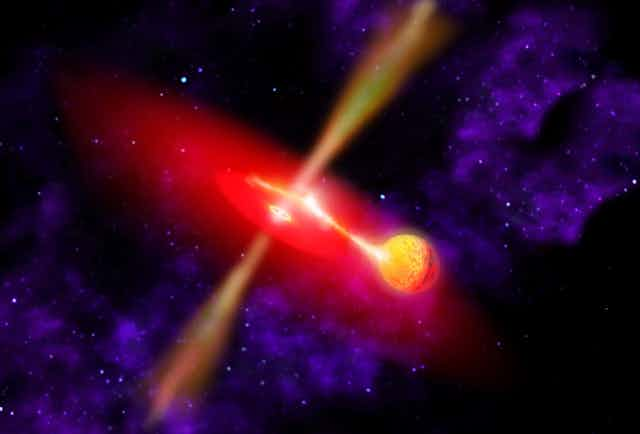While we tend to think of black holes as giant cosmic vacuum cleaners, it’s not all one-way travel. As gas falls in towards a black hole, it spirals gradually inwards like water going down a plug hole – but it’s not all lost; some of it can instead be diverted outwards in narrow, energetic beams known to astronomers as jets.
These jets travel outwards at close to the speed of light, depositing large amounts of energy into their surroundings – and in research published in Nature today, my colleagues and I detected the telltale signatures of ordinary atoms in the jets from a small black hole, just a few times the mass of the sun.
Astronomers have known about jets for almost a century. The first jet was discovered in 1918 by Heber Curtis, coming from the nucleus of the powerful galaxy M87. What he saw as a “curious straight ray” of light was later found to be an intense source of radio waves.
Since then, astronomers have discovered similar jets throughout the universe. However, despite decades of intense study, it is still unclear what these jets are made of.
Heavy jets or light jets?
The bright radio waves that we see from the jets using our radio telescopes here on Earth tell us that the jets must contain electrons. But electrons carry a negative electric charge, and we know the jets must be electrically neutral, so there must be something else to balance out that charge.
The two options are positrons – the antimatter counterparts of electrons – or atomic nuclei.
This isn’t just an academic distinction; the nucleus of hydrogen, the lightest atom, is more than 1,800 times heavier than a positron. The discrepancy with heavier nuclei is even bigger – an iron nucleus is more than 100,000 times heavier than a positron.
Since the energy carried away from the black hole by the jets depends on the mass of the particles within them, a jet containing nuclei can carry away thousands of times more energy than a jet containing electrons and positrons.
That energy eventually gets deposited in the surrounding environment, where its spectacular effects can be seen with radio eyes; in powerful galaxies, the black hole jets are seen to blow enormous bubbles, thousands of light years in length – see the video below.
The smoking gun
As electrons in atoms jump between different energy levels (like rungs on a ladder), they give off light with a characteristic wavelength – in effect, a specific colour – that is unique to the particular atom in question. In the lab, physicists have measured these wavelengths very accurately, so we can immediately associate light of a given wavelength with a given atom.
In our work, we used both the European Space Agency’s XMM-Newton X-ray telescope and CSIRO’s Australia Telescope Compact Array radio telescope to look at a double star system called 4U1630-47. This binary star system consists of a black hole in orbit with a more normal star.
We looked twice at the system during a period when the black hole was feeding very rapidly from its companion star.

In the first observation, we saw no radio emission, and the X-ray spectrum (telling us how the intensity of the X-rays varied with their wavelength) showed just a thin disc of material swirling around the black hole. So far, this was fairly typical – just what had been seen many times before from similar black holes feeding at a high rate.
When we looked again a few weeks later, there had been some exciting changes. First of all, we detected radio waves, telling us that the jets had switched on. At the same time, we detected three emission lines in the X-ray spectrum – light that was characteristic of iron and nickel atoms that had lost most of their electrons.

The wavelength – or colour – of those lines was slightly shifted, telling us that the atoms were moving, just as the pitch of an ambulance siren changes as it moves towards or away from us.
The size of the shifts told us that the atoms were moving fast – at two-thirds of the speed of light – and that they were moving at an angle perpendicular to the disc. Combined with the reappearance of the radio emission, this told us that the atoms had to be located in the jets.
So finally we have direct evidence that jets are composed of “normal”, atomic matter. This had only been seen once before, in the oddball system SS 433. Gas is continuously falling onto that black hole at such a high rate that it may not be representative of more run-of-the-mill black holes, yet our result tells us that its jets may not be so different after all.
Since we expect the physics around a black hole to be the same, no matter how massive it is, then our result should also tell us something about the more powerful jets from the supermassive black holes at the centres of galaxies.
If they also carry atomic nuclei, as now seems likely, the energy being recycled can have a bigger impact, even affecting the formation of stars in the surrounding galaxy.
Knowing what black hole jets are made of is one more piece of the puzzle that may help us to finally unlock the mystery of how the jets are actually launched.

